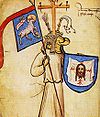Portal:Heraldry
Welcome to the Heraldry and Vexillology Portal!


Vexillology (from the Latin vexillum, a flag or banner) is the scholarly study of flags, including the creation and development of a body of knowledge about flags of all types, their forms and functions, and of scientific theories and principles based on that knowledge. Flags were originally used to assist military coordination on the battlefield, and have evolved into a general tool for signalling and identification, particularly identification of countries.
Heraldry encompasses all of the duties of a herald, including the science and art of designing, displaying, describing and recording coats of arms and badges, as well as the formal ceremonies and laws that regulate the use and inheritance of arms. The origins of heraldry lie in the medieval need to distinguish participants in battles or jousts, whose faces were hidden by steel helmets.
Selected article

Attributed arms are coats of arms given to legendary figures, or to notable persons from times before the rise of heraldry. Beginning in the 12th century, imaginary arms were assigned to the knights of the Round Table, and soon arms were given to biblical figures, to Roman and Greek heroes, and to kings and popes who had not historically borne arms. The specific arms could vary, but the arms for major figures soon became fixed.
Notable arms attributed to biblical figures include the arms of Jesus based on the instruments of the Passion, and the shield of the Trinity. Medieval literature attributed coats of arms to the Nine Worthies, including Alexander the Great, Julius Caesar, and King Arthur. Arms were given to many kings predating heraldry, including Edward the Confessor and William I of England. These attributed arms were sometimes used in practice as quarterings in the arms of their descendants. (more...)
Selected flag

The Flag of Europe is the flag and emblem of the European Union (EU) and Council of Europe (CoE) (it is also used to indicate the euro or eurozone countries). It consists of a circle of 12 golden (yellow) stars on a blue background. The blue represents the west; the number of stars represents completeness while their position in a circle represents unity. The stars do not vary according to the members of either organisation as they are intended to represent all the peoples of Europe, even those outside European integration.
The flag was designed by Arsène Heitz and Paul Lévy in 1955 for the CoE as its symbol, and the CoE urged it to be adopted by other organisations. In 1985 the EU, which was then the European Economic Community (EEC), adopted it as its own flag (having had no flag of its own before) at the initiative of the European Parliament. The flag is not mentioned in the EU's treaties, its incorporation being dropped along with the European Constitution, but it is formally adopted in law. (more...)
Selected biography

Matthew Paris (lit. "Matthew the Parisian"; c. 1200 – 1259) was a Benedictine monk, English chronicler, artist in illuminated manuscripts and cartographer, based at St Albans Abbey in Hertfordshire. He wrote a number of works, mostly historical, which scribed and illuminated himself, typically in drawings partly coloured with watercolour washes, sometimes called "tinted drawings". Some were written in Latin, some in Anglo-Norman or French verse. His Chronica Majora is an oft-cited source, though modern historians recognize that Paris was not always reliable. (more...)
Selected picture

Pursuivants in procession to St George's Chapel, Windsor Castle for the 2006 service of the Order of the Garter: Peter O'Donoghue, Bluemantle Pursuivant of Arms in Ordinary (left), Alastair Bruce of Crionaich, Fitzalan Pursuivant of Arms Extraordinary (right).
Did you know...
- ...that the British First World War general Sir William Peyton (pictured) served as Delhi Herald Extraordinary at the Delhi Durbar of 1911?
- ...that artist Corwin Clairmont designed the Salish-Kootenai's tribal seal when he was 15 and it is still used today?
- ...that in Scottish heraldry, slogans may appear above a crest or coat of arms, or below a main motto?
- ...that according to Chinese scholar Wei Yuan, British ships mistook Chinese red flags for a declaration of war, triggering the First Battle of Chuenpee (1839) in the First Opium War?
- ...that George Hargreaves, Christian Party candidate in the 2008 UK Haltemprice and Howden by-election, said that the dragon symbol on the Welsh flag is "nothing less than the sign of Satan"?
Related portals
|
|
|
Heraldry Web resources
Authorities
- Belgium - The Council of Nobility, Flemish Heraldic Council and Council of Heraldry and Vexillology of the French Community
- Canada - Canadian Heraldic Authority and see also Public Register of Arms, Flags and Badges
- England, Wales, and Northern Ireland - The College of Arms
- Ireland - The Office of the Chief Herald of Ireland
- Netherlands - High Council of Nobility
- Portugal - Instituto da Nobreza Portuguesa
- Scotland - The Court of the Lord Lyon
- South Africa - South African Bureau of Heraldry
- Sweden - National Board of Heraldry, The National Archive
- United States Army - The United States Army Institute of Heraldry
Societies
- Greek Heraldry Society
- The Academy of Heraldic Science Czech republic
- The American College of Heraldry
- The American Heraldry Society
- The Augustan Society
- The Australian Heraldry Society Inc.
- Bulgarian Heraldry and Vexillology Society
- The Center for Research of Orthodox Monarchism
- Cambridge University Heraldic and Genealogical Society
- Chiltern Heraldry Group
- The College of Dracology
- Croatian Heraldic and Vexillologic Association
- The Finnish Heraldic Society
- Fryske Rie foar Heraldyk
- Hellenic Armigers Society
- Guild of Heraldic Artists
- Genealogical Society of Ireland
- Heraldry Research Institute (Japan)
- The Heraldry Society
- The Heraldry Society of Africa
- The Heraldry Society of New Zealand Inc.
- The Heraldry Society of Scotland
- The Heraldry Society of Southern Africa
- The Institute of Heraldic and Genealogical Studies
- The International Association of Amateur Heralds
- Italian Center of Vexillological Studies
- Lancashire Heraldry Group
- Macedonian Heraldry Society
- New England Historic Genealogical Society Committee on Heraldry
- Norwegian Heraldry Society
- Oxford University Heraldry Society
- Polish Heraldry Society
- Polish Nobility Confederation
- Real Academia Matritense de Heráldica y Genealogía - Royal Academy of Heraldry and Genealogy of Madrid
- Romanian Institute for Genealogy and Heraldry
- The Royal Heraldry Society of Canada
- The Russian College of HeraldryThe Russian College of Heraldry
- Serbian Heraldic Society
- Societas Heraldica Scandinavica
- Societas Heraldica Slovenica
- Swedish Heraldic Society
- Ukrainian Heraldry Society
- Royal Association Genealogical and Heraldic Office of Belgium
Vexillology
Software
- Coat of Arms Visual Designer web-based program
- Puncher Heraldry Program
- Blazonry Server - pyBlazon
- DrawShield - creates SVG shield or arms image from blazon
- CoaMaker - web-based tool
- Blazon95 and BLAZONS! 2000, older Windows applications
Texts
- Heraldry, historical and popular : with seven hundred illustrations (1863)
- A Complete Guide to Heraldry (1909)
Other
Wikimedia
The following Wikimedia Foundation sister projects provide more on this subject:
-
Commons
Free media repository -
Wikibooks
Free textbooks and manuals -
Wikidata
Free knowledge base -
Wikinews
Free-content news -
Wikiquote
Collection of quotations -
Wikisource
Free-content library -
Wikispecies
Directory of species -
Wikiversity
Free learning tools -
Wikivoyage
Free travel guide -
Wiktionary
Dictionary and thesaurus












